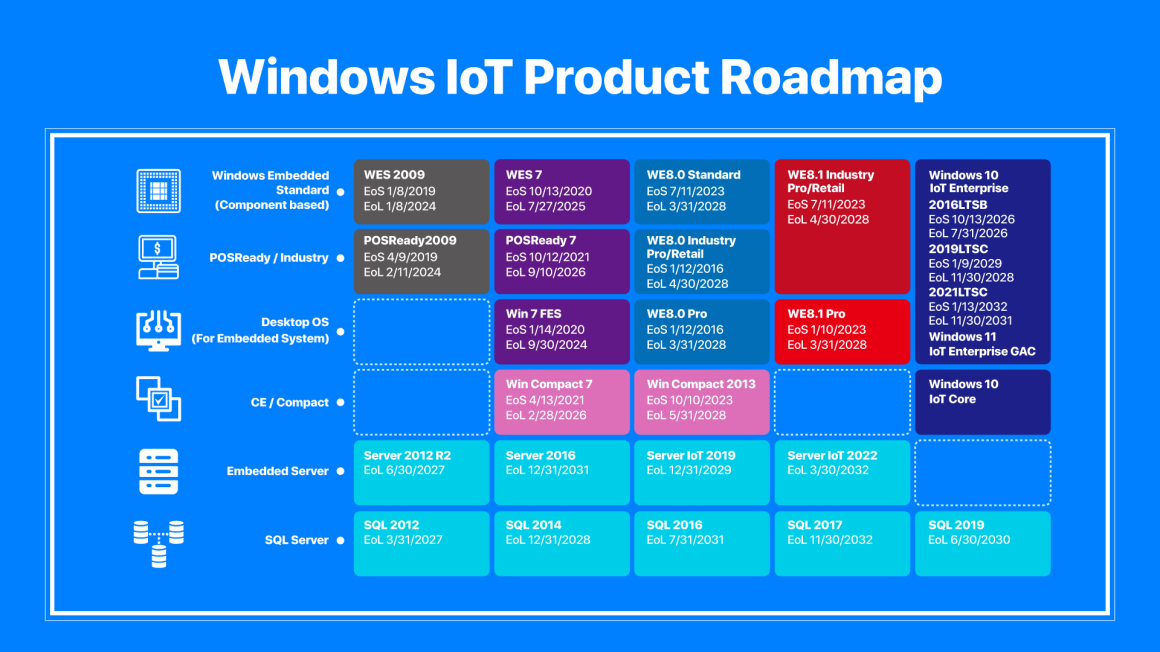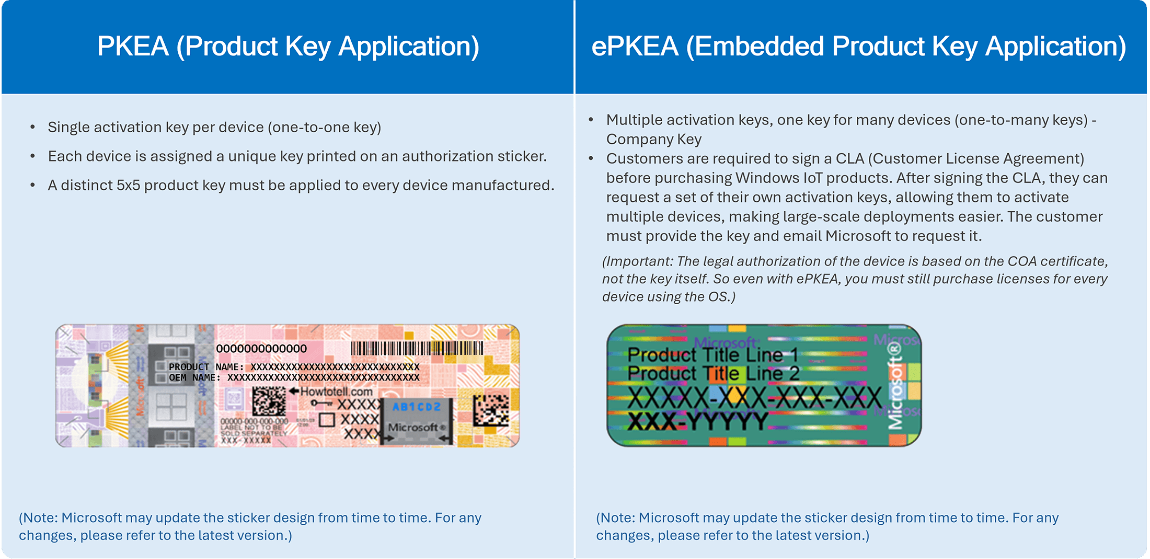Windows OS
Windows IoT Enterprise
Windows IoT (Embedded) Enterprise LTSC License
C&T Solution is an authorized agent of Microsoft Embedded Licenses that provides various versions of genuine Windows 10 IoT Enterprise LTSC and Windows 11 IoT Enterprise LTSC Licenses.
What is Windows IoT Enterprise?
Windows IoT Enterprise is a full-featured version of Windows Enterprise, specifically designed to provide enterprise-grade management and security for IoT solutions. It shares all the advantages of the global Windows ecosystem and is binary equivalent to Windows Enterprise. This means you can leverage the same familiar development and management tools used for client PCs and laptops.
However, the IoT and desktop versions differ when it comes to licensing and distribution. Windows IoT Enterprise is specifically intended for fixed-purpose devices. It offers two deployment options: the General Availability Channel (GAC) and the Long-Term Servicing Channel (LTSC).
C&T Solution provides Windows IoT Enterprise LTSC with a 10-year support lifecycle, ideal for fixed-purpose devices where consistent functionality over time is essential.
About Windows IoT Enterprise LTSC
Windows IoT Enterprise LTSC is tailored for specialized devices and applications where stability in features and functionality is required throughout the device’s lifespan. These are often devices that need regulatory certification or that perform critical business functions over several years using the same operating system version. Common industries utilizing such devices include banking, kiosks, digital signage, industrial automation, healthcare, hospitality, manufacturing, and retail.
Microsoft designed Windows IoT Enterprise LTSC with these specific use cases in mind, offering 10 years of support for each release. During this period, features and functionality remain unchanged to ensure the consistency that critical devices require.
While each new version of Windows brings exciting features and capabilities, Windows IoT Enterprise LTSC focuses on providing long-term stability for devices where frequent updates are not desirable.
Differences Between Windows 10/11 IoT vs. Windows 10/11 Pro
|
|
Windows 10/11 Pro |
|
|
SKU selection based on CPU platform |
High End/ Value/Entry SKU |
Only One SKU |
|
Service |
10 Years from Listing |
3 Years from Listing |
|
Update Version |
Distinguish between LTSC long-term support version/GAC once a year |
GAC once a year |
| Feature | Window 11 IoT Enterprise LTSC 2024 | Window 11 IoT Enterprise Non-LTSC 2024 | Window 10 IoT Enterprise LTSC 2021 | Window 10 IoT Enterprise LTSC 2019 |
| Version | 24H2 | 24H2 | 21H2 | 1809 |
| Life cycle | 10 years | 36 months | 10 years | 10 years |
| Removable Packages | 36 Removable Packages | Not supported | 20 Removable Packages | Not supported |
| TPM Requirements | Optional | Optional | Not required | Not required |
| Support Wi-Fi 6E & USB 4.0 | Supported | Supported | No supported | No supported |
| Support ARM64 | Qualcomm IoT, NXP I. MX9 | Qualcomm IoT, NXP I. MX9 | NXP i.MX8 | GAC |
| Support Copllot | No Supported | Supported | No Supported | No Supported |
Matching the Windows 10/11 IoT Enterprise SKU based on the CPU Platform
A guide to Windows IoT Enterprise value-based pricing
|
Group Tier |
CPU Platform (updated on: 01/05/2023) |
|
High-End |
Intel:
AMD:
All other non-specified CPUs |
|
Value |
Intel:
AMD: RX-Series1, FX Models1, A8, A10, A12, A13xx-V19xx, V24xx-V29xx, Ryzen 3, Ryzen 5 Selected EPYC 3000 (3101, 3151) Qualcomm: Snapdragon 8503, 7c, 7c Gen 2, 8c, 8cx, 8cx Gen 2, Microsoft SQ1, Microsoft SQ2 |
|
Entry |
Intel:
AMD: R1xxx-R25xxx, E1, E2, E-350, A4, A6, A9, G-Series, V10xx-V12xx, V20xx-V23xx, Athlon, 3000-Series Qualcomm: QCS6490, QCS5430 VIA: All |
|
Base |
NXP: i.MX 8 Series2 (M, Mini, Nano), i.MX93 |
1 All processors within the specified processor family are included, unless explicitly listed under a different pricing category
2 Applicable only to Windows 10 (not available for Windows 11)
3 Devices with these CPUs may not be manufactured with Windows 11 pre-installed but may be upgraded to Windows 11 by the end customer.
Note: For clarification, this list is solely for determining processor eligibility under Windows 10/11 IoT Enterprise value-based pricing. It is not a technical reference for processor compatibility with Windows 10/11 IoT Enterprise products. All information is provided without warranty.

Windows 10 IoT and Windows 11 IoT Roadmap
Windows 10/11 IoT Enterprise Certificate of Authorization (COA) Sticker

Hardware Requirements of Windows 10 IoT and Windows 11 IoT Enterprise
If you are currently on Windows 10 and would like to compare Windows 10 and 11 IoT, below is a table that details the main hardware requirement differences between components such as CPU, RAM, Storage, Graphics, Display, TPM, and firmware requirements.
|
|
Windows 10 IoT |
Windows 11 IoT |
|
Processor |
1 GHz clock speed (32-bit/64-bit) |
1 GHz (2 cores) or faster processor (64-bit) |
|
RAM |
1 GB for 32-bit, 2 GB for 64-bit |
4 GB or more |
|
Storage |
16 GB for 32-bit, 20 GB for 64-bit |
64 GB or more |
|
Graphics card |
DirectX 9 or later with WDDM 1.0 driver |
DirectX 12 compatible graphics card or later with WDDM 2.0 driver |
|
Display resolution and cable |
800 x 600 or higher resolution (VGA, DVI, HDMI, DisplayPort) |
1366 x 768 or higher resolution (HDMI 1.4 and later, DisplayPort 1.2 and later) |
|
TPM (Trusted Platform Module) |
Versions 1.2 and 2.0 supported |
Version 2.0 required |
|
System BIOS & Firmware |
Supports both UEFI (optional) and legacy BIOS |
Requires UEFI firmware with SecureBoot |
|
|
Windows 10 IoT |
Windows 11 Pro |
|
Interface upgrades |
Traditional User Interface |
New and modern user interface, improved touch support, and support for new input devices such as pen and voice. Streamlined and intuitive for enhanced user-experience. |
|
Linux GUI Subsystem |
Not available |
Available |
Contact C&T experts for more information | Click Here
FAQs
- What is the difference between Windows IoT and Windows Embedded?
Windows IoT is the successor to Windows Embedded and provides a more modern platform for IoT devices. Windows Embedded was designed for specific embedded systems, while Windows IoT Enterprise offers a full-featured operating system with enhanced security, management, and scalability for a wide range of IoT applications. Windows IoT also integrates with the broader Windows ecosystem, making it easier to develop, deploy, and manage devices.
- Why choose Windows IoT Enterprise over Windows Pro?
If you're developing an OEM appliance such as point-of-sale systems, retail devices, industrial automation equipment, digital signage, medical equipment, or any other device with a screen, Windows IoT Enterprise is the ideal solution. It is specifically designed for fixed-purpose devices, offering enterprise-grade security and manageability tailored to such applications.
- Are Windows Pro and Windows IoT Enterprise the same? Can I upgrade to Windows IoT Enterprise?
Windows Pro and Windows IoT Enterprise are distinct operating systems with different purposes. There is no direct upgrade, downgrade, or migration path between them. Each version is designed for specific use cases, so a shift from one to the other requires a separate deployment.
- What are the licensing requirements for Windows IoT Enterprise?
Windows IoT Enterprise requires an OEM or CLA (Customer License Agreement) license for deployment. The licensing is based on the type of device and its usage, ensuring that devices built with Windows IoT Enterprise comply with Microsoft's licensing policies. Each device requires its own license, whether it uses the PKEA (Product Key Application) or ePKEA (Embedded Product Key Application).
- Does Windows IoT Enterprise require internet connectivity?
No, Windows IoT Enterprise does not require constant internet connectivity. It is designed for devices that may operate in environments with limited or no internet access, such as industrial systems, point-of-sale machines, or medical devices. However, internet access may be required for initial activation and updates, depending on the deployment scenario.
- How does Windows IoT Enterprise handle security updates?
Windows IoT Enterprise LTSC provides critical security updates throughout its 10-year lifecycle, ensuring long-term device protection without introducing new features or changes that could affect device functionality. This makes it ideal for devices that require high security and stability, such as medical equipment or industrial systems.
- What is the difference between Windows LTSB and LTSC?
Windows LTSB (Long-Term Servicing Branch) and LTSC (Long-Term Servicing Channel) are essentially the same concept under different naming conventions. Microsoft renamed LTSB to LTSC starting with Windows 10. Both refer to a servicing model designed for specialized devices that require stability and minimal changes over time, offering up to 10 years of support with only security and critical updates, not feature updates.
- Why use Windows IoT Enterprise LTSC instead of SAC?
Windows IoT Enterprise LTSC is ideal for devices that need long-term stability and minimal updates, such as medical devices, industrial systems, and point-of-sale machines. In contrast, the Semi-Annual Channel (SAC) delivers frequent feature updates, which are more suited to general-purpose devices that need to stay current with the latest advancements. LTSC provides up to 10 years of support, ensuring devices can maintain a consistent environment over their operational lifespan.

